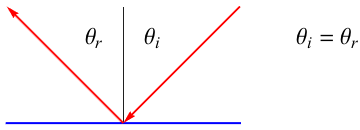Reflection
We're Not Soul-Searching
Reflection is probably the simplest property of light for us to understand because we've had good bit of experience with it. Every time we've played pool, looked in a mirror, or played ice hockey, reflection was present.When the puck (or 8 ball or image) hits a solid object, it changes course, bouncing off at an angle. Light does exactly the same thing: it reflects.
Reflection is summarized by…wait for it…the law of reflection.This law says that the angle at which light hits an object, the angle of incidence, θi, equals the angle at which it reflects from that object, the angle of reflection, θr. In other words, or symbols, θi = θr.

Since this is physics, these angles are not the angles between the surface of the object and the light ray. That would be too straightforward. Instead, to define these angles, we have to imagine a line sticking straight out of the surface of the reflecting object. Are we imagining? So we're all imagining a line perpendicular to the surface of the reflecting object, we call this perpendicular line the normal. The angles of incidence and reflection are the angles between the light's direction and the normal.
The next thing to know about reflection is that we distinguish between two different kinds: specular reflection and diffuse reflection.
Specular reflection is what a mirror does or what we see on perfectly flat water. A perfectly flat surface reflects incoming parallel light rays in such a way that they all stay parallel. Specular reflection is the principle behind "shiny." And at its best, as in the case of mirrors, it generates a reflection. We'll talk more about mirrors in the next In Depth Section.
The second type of reflection is what happens with most objects. It's called diffuse reflection. All of the things we see that are not shiny or "reflective," are the result of diffuse reflection. Objects that partake in diffuse reflection (almost everything, even you) are uneven. These objects still reflect all of the individual light rays as described by the law of reflection, but because the surface the light rays hit is uneven, they are not all reflected back at the same angle.
Totally lost? Then it's time to bust out our inner Picasso and a draw a picture. For each scenario draw out the surface (in blue), the light rays (in red), and don't forget to draw the normal to the surface for each light ray (in black). It will look like this:

Yes, that diffuse reflection is nice and abstract à la Picasso. The surface of a desk looks pretty flat to our eyes, but it generates diffuse reflection. Strange? Not really. At a microscopic level, the level at which light rays see your desk, your desk is pothole-ier than the worst of New York City's streets. It's just as well: it'd be awful hard to study chemistry if our own (specular) reflections competed for our attention.
Next, let's talk total internal reflection. Scientists have learned how to capitalize on this phenomenon in communications. Fiber optics utilize total interior reflection with no light escaping a medium by refraction. What happens is the light is at a high enough angle (with respect to the normal) within a medium that for it to refract out to the air requires an angle greater than 90, which wouldn't be in the air anyway. Instead it reflects within the medium, bouncing back and forth its entire length until it finds an angle at which it may exit, at the other side.